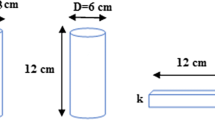Conclusions
-
1.
Processes of siltation by sediments and overgrowth by algae are, as a rule, observed in concrete channels of irrigation canals at low flow velocities, which leads to a considerable increase of the roughness coefficient and hydraulic resistance of the channel. Algae develop more intensely in concrete channels than in earth channels as a consequence of their self-purifying capacity.
-
2.
Relations are proposed for determining the minimum and maximum design velocities in concrete canal channels providing their high hydraulic efficiency and operating reliability. On the basis of calculations and an analysis of on-site data, it is recommended to assign the design velocity in concrete channels from 0.55 to 4.0 m/sec.
-
3.
The validity of the logarithmic law of resistance in concrete canal channels both for tranquil and rapid flow was confirmed. However, the regularities of the change in the hydraulic resistances of these flows are different: for tranquil flows the resistance coefficients decrease with increase of the Reynolds number, and for rapid flows they increase.
-
4.
On the basis of a statistical analysis of on-site data, a normal distribution law of the values of the roughness coefficient of concrete canal channels and a reliable interval of variation of their values within n=0.0165–0.0174 were established. In practical calculations the roughness coefficient of concrete linings of irrigation canals should be taken equal to n=0.0170, which corresponds to the on-site data to a maximum degree with a probability greater than 98%.
Similar content being viewed by others
Literature cited
Yu. M. Kosichenko, Hydraulics of Reclamation Canals [in Russian], NIMI, Novocherkassk (1992).
Yu. M. Kosichenko, N. I. Turhyanskaya, and N. E. Bogomolov, “On-site hydraulic investigations of the roughness coefficient of lined canals,” Rostovskii TsNTI, Rostov-on-Don, No. 69–91 (1991).
I. A. Dolgushev, Increase of the Operating Reliability of Irrigation Canals [in Russian], Kolos, Moscow (1975).
O. P. Oksiyuk, Algae of the World's Canals [in Russian], Naukova Dumka, Kiev (1973).
Ts. E. Mirtskhulava, Reliability of Large Canals [in Russian], Kolos, Moscow (1981).
Ts. E. Mirtskhulava, Erosion of Channels and Methods of Estimating Their Stability [in Russian], Kolos, Moscow (1967).
SNiP 2.06.03-85. Reclamation Systems and Structures [in Russian], Stroiizdat, Moscow (1986).
V. Ya. Gorenbein, Wear Resistance of Linings of Hydraulic Structures [in Russian], Énergiya, Moscow (1967).
Yu. A. Ibad-Zade, Feeder Canals [in Russian], Stroiizdat, Moscow (1975).
A. I. Kuznetsov and A. A. Zaporozhets, “On-site investigations of the roughness coefficients of the North Donets-Donbas canal,” Gidrotekh. Stroit., No. 7 (1976).
O. M. Aivazyan, “Investigations of tranquil and rapid flows in smooth-walled and reinforced-concrete flume canals,” Gidrotekh. Stroit., No. 2 (1984).
O. M. Aivazyan, “Hydraulic resistances and capacity of uniform aerated and unaerated rapid flows in concrete channels,” Gidrotekh. Stroit., No. 6 (1992).
O. M. Aivazyan and Kh. Zh. Makhmudov, “Investigation of the hydraulic resistance of rapid unaerated flows in concrete channels,” Gidrotekh. Stroit., No. 3 (1992).
A. D. Al'tshul', V. V. Kazennov, É. N. Polyakova, and A. P. Voinovich, “Calculation of head losses due to friction in concrete canals,” Izv. VNIIG im. B. E. Vedeneeva,138 (1980).
A. D. Al'tshul', Yu. A. Voitinskaya, V. V. Kazannov, and É. N. Polyakova, Hydraulic Friction Losses in Conduits at Electric Power Stations [in Russian], Énergoatomizdat, Moscow (1985).
Additional information
Translated from Gidrotekhnicheskoe Stroitel'stvo, No. 8, pp. 32–38, August, 1993.
Rights and permissions
About this article
Cite this article
Kosichenko, Y.M. Permissible velocities and variability of hydraulic resistances in concrete canal channels. Hydrotechnical Construction 27, 476–483 (1993). https://doi.org/10.1007/BF01545142
Issue Date:
DOI: https://doi.org/10.1007/BF01545142




